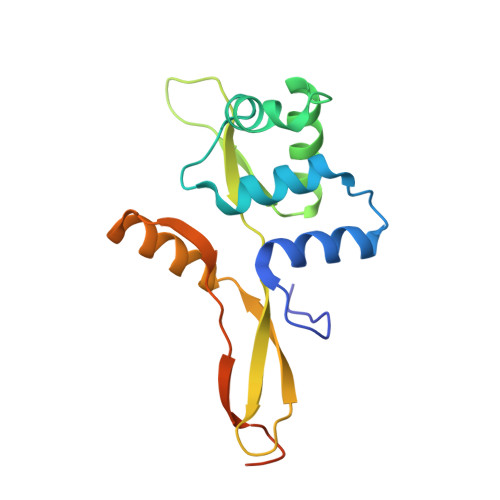Crystal Structure of Peroxide Stress Regulator from Streptococcus pyogenes Provides Functional Insights into the Mechanism of Oxidative Stress Sensing.
Makthal, N., Rastegari, S., Sanson, M., Ma, Z., Olsen, R.J., Helmann, J.D., Musser, J.M., Kumaraswami, M.(2013) J Biol Chem 288: 18311-18324
- PubMed: 23645680
- DOI: https://doi.org/10.1074/jbc.M113.456590
- Primary Citation of Related Structures:
4I7H - PubMed Abstract:
Regulation of oxidative stress responses by the peroxide stress regulator (PerR) is critical for the in vivo fitness and virulence of group A Streptococcus. To elucidate the molecular mechanism of DNA binding, peroxide sensing, and gene regulation by PerR, we performed biochemical and structural characterization of PerR. Sequence-specific DNA binding by PerR does not require regulatory metal occupancy. However, metal binding promotes higher affinity PerR-DNA interactions. PerR metallated with iron directly senses peroxide stress and dissociates from operator sequences. The crystal structure revealed that PerR exists as a homodimer with two metal-binding sites per subunit as follows: a structural zinc site and a regulatory metal site that is occupied in the crystals by nickel. The regulatory metal-binding site in PerR involves a previously unobserved HXH motif located in its unique N-terminal extension. Mutational analysis of the regulatory site showed that the PerR metal ligands are involved in regulatory metal binding, and integrity of this site is critical for group A Streptococcus virulence. Interestingly, the metal-binding HXH motif is not present in the structurally characterized members of ferric uptake regulator (Fur) family but is fully conserved among PerR from the genus Streptococcus. Thus, it is likely that the PerR orthologs from streptococci share a common mechanism of metal binding, peroxide sensing, and gene regulation that is different from that of well characterized PerR from Bacillus subtilis. Together, our findings provide key insights into the peroxide sensing and regulation of the oxidative stress-adaptive responses by the streptococcal subfamily of PerR.
Organizational Affiliation:
Center for Molecular and Translational Human Infectious Diseases Research, The Methodist Hospital Research Institute, and Department of Pathology and Genomic Medicine, The Methodist Hospital System, Houston, Texas 77030, USA.
















